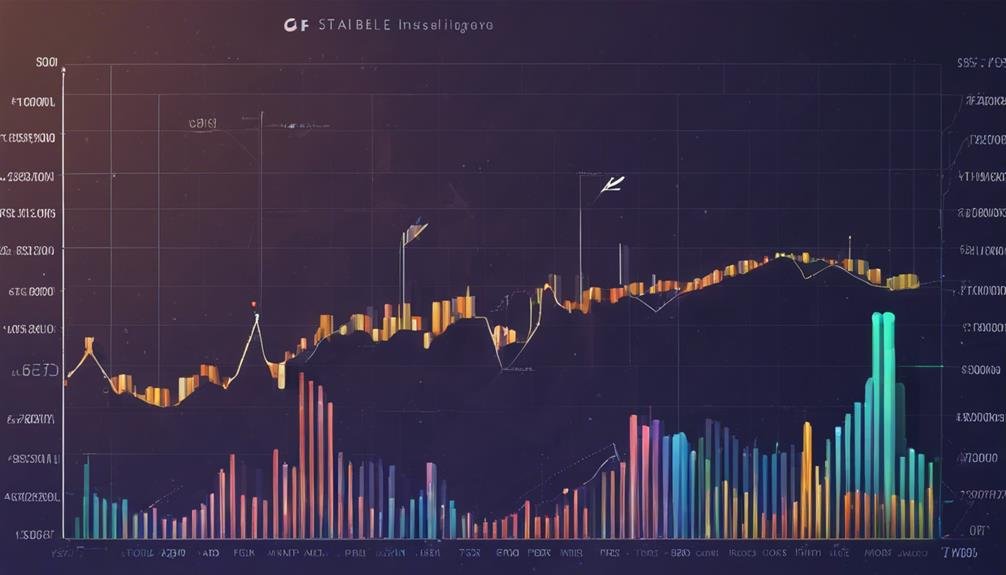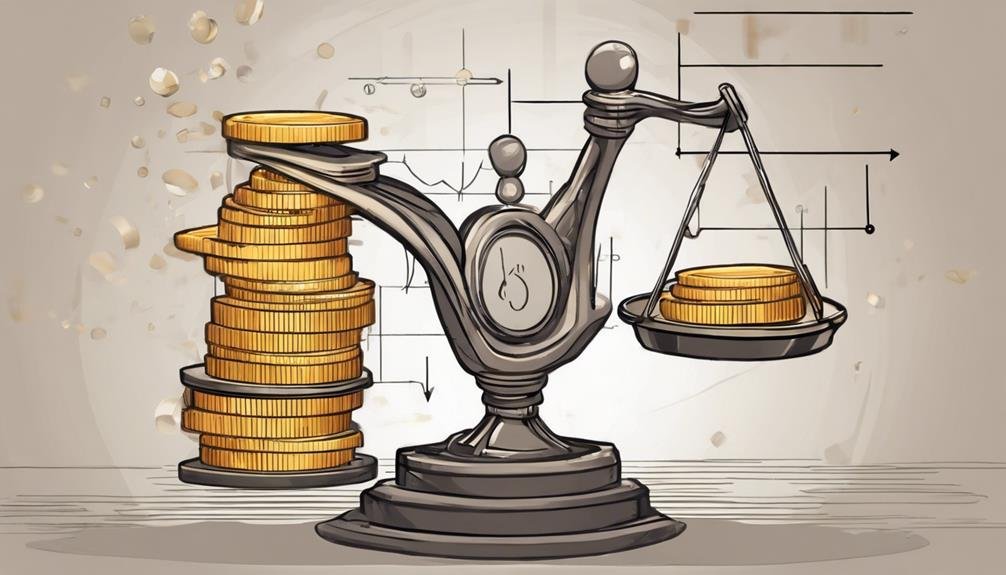Consider over-collateralization, algorithmic adjustments, and redeemability when comparing stablecoin price stabilization techniques. Analyze historical performance for insights. Understand how Bitcoin’s volatility affects stablecoin prices. Estimating theoretical distribution moments like mean and skewness can reveal stabilization effectiveness. Evaluate stability mechanisms, historical data, and responses to market shocks.
Choose stablecoins with proven resilience for fluctuating markets. Explore methods like over-collateralization, algorithmic adjustments, and redeemability for stablecoin value maintenance. More insights await on stablecoin price stabilization techniques.
Table of Contents
Brief Overview of Comparing Stablecoin Price Stabilization Methods
- Evaluate over-collateralization ratios for stability assessment.
- Analyze algorithmic adjustments’ effectiveness in response to market conditions.
- Consider redeemability mechanisms for underlying assets.
- Compare seigniorage shares and dynamic coin supply strategies.
- Assess historical performance in maintaining price pegs.
Understanding Stablecoin Price Stability
Understanding stablecoin price stability is essential for evaluating the resilience of the stablecoin ecosystem. Stablecoins, a cryptocurrency designed to minimize price volatility, rely on various price stabilization mechanisms to maintain a steady peg to the underlying asset. These mechanisms, such as over-collateralization, algorithmic adjustments, and redeemability, ensure stablecoin prices remain relatively stable in decentralized payment systems.
A survey of stablecoin price stabilization techniques reveals the importance of monetary stabilization in the digital asset space. The ability of stablecoins to effectively stabilize their prices can impact investor confidence and the widespread adoption of these digital assets. By analyzing the historical performance and response of stablecoins to market fluctuations, valuable insights can be gained regarding the effectiveness of their price stabilization mechanisms.
This understanding is crucial for investors, developers, and regulators in evaluating stablecoin projects’ long-term sustainability and viability.
Analyzing Volatility Spillovers

To understand the impact of Bitcoin’s fluctuations on stablecoin volatility, examine the analysis of volatility spillovers between these assets. Volatility spillovers refer to changes in the price of one asset, such as Bitcoin, that can influence the volatility of stablecoins. This analysis is important for grasping the interconnectedness between Bitcoin‘s movements and the stability of stablecoin prices. Volatility spillovers can greatly affect the stability of stablecoins, shaping their value and impacting market dynamics.
Researchers utilize log-log transformations to study volatility spillovers, enabling them to quantify the relationship between asset classes like Bitcoin and stablecoins. By understanding volatility spillovers, one can better evaluate the risk and stability of stablecoins within the broader cryptocurrency market. This analytical approach provides valuable insights into how fluctuations in Bitcoin can reverberate across the market, influencing the price stability of stablecoins and overall market dynamics.
Estimating Theoretical Distribution Moments

When estimating theoretical distribution moments, you can gain valuable insights into the statistical properties of stablecoin price stabilization techniques. You can better understand the shape and risk factors of different stabilization mechanisms by analyzing moments like mean, variance, and skewness. These techniques provide a systematic way to assess the stability and predictability of the market, offering a deeper understanding of price distribution dynamics.
Moments in Distribution
Exploring the statistical measures that describe the shape and behavior of a probability distribution, such as mean, variance, skewness, and kurtosis, sheds light on the underlying stability and variability of data points. These moments in distribution play an important role in understanding how decentralized mechanisms for stablecoin price stabilization operate. By estimating theoretical distribution moments, one can gain insights into the price stabilization methods used and their effectiveness in maintaining a stable value.
Analyzing these moments helps in comparing different stabilization techniques and their impact on the stability of prices. Decentralized mechanisms rely on these moments to gauge the behavior of prices, enhancing the overall understanding of how stablecoin prices fluctuate and respond to market conditions.
Theoretical Estimation Techniques
Estimating theoretical distribution moments plays a pivotal role in understanding the dynamics of stablecoin price stabilization techniques. These techniques involve using power laws to estimate distribution moments, aiding in evaluating stabilization mechanisms for decentralized payment systems like the Ethereum blockchain. Researchers can gain valuable insights into how these coins interact with market prices and other factors by delving into the theoretical aspects of stablecoin price movements.
This analysis is essential for evaluating the effectiveness of various stabilization techniques and determining their impact on price stability. Moreover, understanding theoretical distribution moments is vital for evaluating the efficiency and robustness of different approaches to stabilizing stablecoin prices. Researchers can use text and data mining to explore these dynamics while adhering to Creative Commons licensing terms.
Statistical Analysis Insights
To gain a deeper understanding of stablecoin price stabilization techniques, you can analyze theoretical distribution moments using power laws to assess the stability and volatility of these digital assets. By delving into stability analysis through power laws, you can uncover important insights into the distribution characteristics of stablecoin price movements. This method allows for a detailed volatility assessment by examining moments of the probability distribution, including mean, variance, skewness, and kurtosis.
Estimating theoretical distribution moments is essential for evaluating the stability and volatility of stablecoin prices, enabling researchers to identify patterns and trends in price movements. Through this statistical approach, a clearer picture emerges, aiding in comparing and analyzing different stablecoin price stabilization techniques.
Impact of Bitcoin Volatility

Bitcoin’s price fluctuations profoundly impact the stability mechanisms of stablecoins. As research suggests, the volatility of Bitcoin greatly influences the volatility of stablecoins, creating a complex interplay in the cryptocurrency market. Analyzing this relationship through various mathematical models can uncover insights into how Bitcoin’s volatility shapes the behavior of stablecoin prices.
Bitcoin Price Influence
Bitcoin’s volatility greatly influences stablecoin prices, impacting their stability and responding to Bitcoin price fluctuations. The relationship between Bitcoin volatility and stablecoin prices reveals insights into volatility spillovers and power laws. Analyzing how stablecoin prices react to Bitcoin’s movements showcases the interconnectedness of these digital assets. The estimation of theoretical distribution moments using power laws aids in understanding the dynamics of stability between Bitcoin and stablecoins.
As Bitcoin experiences price fluctuations, this serves as a driving force for the volatility in stablecoins, leading to significant price movements. Understanding the influence of Bitcoin on stablecoin prices is essential for investors and market participants to navigate the intricate dynamics of the cryptocurrency ecosystem.
Stability Mechanism Analysis
Stablecoin volatilities exhibit statistical instability when analyzed with Bitcoin volatility, highlighting the critical impact of Bitcoin’s fluctuations on stablecoin stability. The Granger-causal effect of Bitcoin volatility on stablecoin volatilities underscores the significant influence of Bitcoin’s price movements on stablecoins’ stability. Research utilizing power laws to estimate distribution moments reveals volatility spillovers between Bitcoin and stablecoins, indicating a close interdependence.
These findings emphasize the necessity of comprehending how Bitcoin volatility affects price stabilization techniques for stablecoins. By understanding the intricate relationship between Bitcoin volatility and stablecoin stability, developers and investors can implement more effective strategies to mitigate the impact of external market fluctuations on the value and reliability of stablecoin assets.
Statistical Instability of Stablecoins

The statistical instability of stablecoins is evident in their volatility processes and close ties to Bitcoin volatility fluctuations. Researchers have uncovered unstable characteristics when analyzing stablecoin prices using power laws for distribution moments estimation, indicating a lack of predictability in their pricing behavior. As observed through log-log transformations, volatility spillovers between stablecoins and Bitcoin highlight the dynamic relationship between these assets.
The results of these analyses consistently point towards the statistical instability of stablecoins, emphasizing their sensitivity to changes in Bitcoin volatility. This interconnected nature suggests that the volatility of Bitcoin plays a significant role in driving the volatility of stablecoins, making them susceptible to external influences. Understanding this statistical instability is essential for investors and users of stablecoins, as it underscores the need for careful monitoring and risk management strategies to effectively navigate the fluctuations in their value.
Making Informed Decisions

Considering the stability mechanisms and historical price data of various stablecoins, your decisions should be informed by evaluating their effectiveness in maintaining price pegs. When comparing stablecoins for price stability, here are three essential factors to keep in mind:
- Stability Mechanisms: Assess the different mechanisms stablecoins employ to stabilize their prices. Check whether these mechanisms have successfully prevented major deviations from the intended peg.
- Historical Price Data: Examine the historical price data and volatility of the stablecoins under consideration. This analysis can provide insights into how well a stablecoin has maintained its peg during various market conditions.
- Transparency and Market Shocks: Evaluate the transparency of the stablecoin’s operations and how they handle unexpected market shocks. A transparent stablecoin with proven resilience in market fluctuations may be more trustworthy in maintaining its peg.
Dynamics of Price Stabilization

Exploring the mechanisms for stabilizing prices in stablecoins reveals the intricate dynamics of maintaining their pegs effectively. Price stabilization in stablecoins can be achieved through various methods such as over-collateralization, algorithmic adjustments, redeemability for underlying assets, seigniorage shares, and dynamic coin supply mechanisms. Overcollateralization involves securing the stablecoin supply with more assets than the circulating supply to guarantee stability.
Algorithmic adjustments, which react to supply and demand, help stabilize stablecoin prices by altering the coin supply accordingly. Redeemability for underlying assets allows users to swap stablecoins for the assets they are pegged to, ensuring price stability. Additionally, seigniorage shares and dynamic coin supply mechanisms are implemented to manage the supply of stablecoins and stabilize their value over time.
Understanding these dynamics is essential for comprehending how stablecoins maintain their pegs and provide a reliable means of value transfer in the digital asset space.
Frequently Asked Questions
How Would You Assess the Stability of Stablecoins?
Assess stablecoin stability by analyzing price volatility, market dynamics, and stability indicators. Compare stability metrics through historical data and risk management techniques. Understand price stability mechanisms to evaluate and measure stablecoin stability effectively.
How Do Stablecoins Stabilize Their Prices?
To stabilize their prices, stablecoins utilize market dynamics and algorithmic models. They employ supply mechanisms and reserve backing, maintain liquidity pools, and adjust collateralization ratios. Price pegs and redeemability create arbitrage opportunities, while fiat reserves guarantee stability.
What are the different methods used to achieve Stability for Stablecoins?
Stablecoins utilizes methods like reserve backing and algorithmic models to adjust supply based on market dynamics to achieve stability. They peg to fiat, manage risk, and offer economic incentives with decentralized governance for liquidity provision.
What Is the Best Strategy for Stablecoin?
When determining the best strategy for stablecoin, market analysis, risk assessment, liquidity management, economic modeling, and algorithm optimization play vital roles. Understanding these elements helps you make informed decisions for stablecoin price stabilization.
Conclusion
In summary, when comparing stablecoin price stabilization techniques, remember that unpredictability is the only certainty in the crypto world. So, go ahead and examine, assess, and make informed decisions, but always be ready for unforeseen twists and turns. Moving through these methods can be quite the rollercoaster ride like a stablecoin’s price stability. Buckle up and enjoy the adventure!




